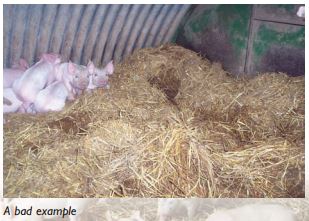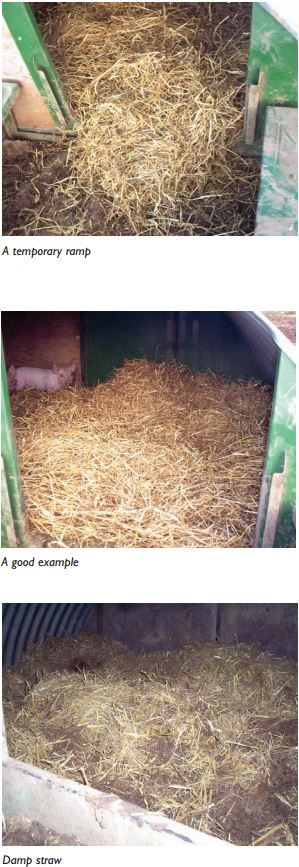



How to Straw Up at Farrowing to Protect Your Piglets
This guide from AHDB Pork explains how to protect piglets from the cold by strawing up farrowing arcs.Outdoor pig production does not allow for close supervision of farrowing or observation of young piglets; it is therefore more difficult to manage pre-weaning mortality than in indoor systems.
At birth piglets are exposed to a colder environment and as they are unable to generate heat themselves they can rapidly become chilled, as further heat is lost to the environment, especially in cold months.
Chilled piglets die from hypothermia, are slower to reach the teat and are more likely to be laid on.
Strawing up farrowing arcs correctly can help combat piglet mortality in outdoor systems by reducing heat loss. On an 800 sow outdoor unit, reducing mortality by 1 per cent is worth around £8,800 (or 50p per pig).
Targets:
The top third of UK outdoor herds achieve the following results (Agrosoft Ltd.):
- Mortality rate of pigs born alive = 8.4 per cent
- Mortality rate of total pigs born = 13.5 per cent
- Average number of pigs weaned per litter = 9.98
Draughts
- Make sure any holes in arcs are blocked up with straw to reduce draughts. Draughts cause piglets to lie in unfavourable areas where they are at greater risk of being laid on.
- Use a spray marker to colour the tops of arcs that have holes in; this will make it easier for you and your staff to identify which arcs need attention.
Pre-farrowing
- Check prior to farrowing whether more straw is needed.This is especially important if strawing up is unlikely to occur at weekends; make sure enough straw is provided on Friday.
Provide wheat straw for nest building; if this is not available use chopped barley straw. Barley straw should be avoided at farrowing as the stems are long and stalky and can get wrapped around the piglets.- Excessive amounts of straw can cause problems. Newborn piglets will not have the strength to push through large amounts of straw to get to the teats. They may get stuck underneath it and be at a greater risk of being laid on.
- Place the wads of straw on the ground before the arc is tipped back over as this will save time and effort.
1-48 hours post-farrowing
- It is advisable to leave bedding alone during the first 48 hours post farrowing. Any disruption of the bed/nest can break the newly established feeding pattern between sow and piglets.
- Do not forget to take into consideration the amount of liquid produced during farrowing and its contribution to dampening the straw.
- Providing too much straw too quickly can cause problems. Young piglets will not have the strength to push through large amounts of straw and may get stuck underneath it; this puts piglets at greater risk of being laid on by the sow.
- If there is a step in and out of the arc consider placing some straw in the fender area to make a temporary ramp. If piglets fall out of the arc they will then be able to climb back in.
First two weeks post-farrowing
- If you check piglets/beds while the sow is feeding. remember that the piglets’ greatest heat source has just left the arc.
- Observe the sows’ behaviour and react accordingly. Sows that spend a long time away from the arc will not be providing heat and more straw will be needed for insulation. Where sows only leave to feed and drink, less straw will be required as piglets will gain heat from the sow for most of the day.
General
- Straw should be dry; wet straw should be discarded or used elsewhere to reduce the risk of piglets becoming chilled.
- If the ground is uneven poor quality straw can be used to level it out before positioning the arcs; this will also help to reduce draughts and improve drainage.
- Store straw in a clean, dry environment to maintain quality.
- Adjust your strawing up routine according to the weather conditions; if bad weather is expected increase the straw levels in the arcs.
- Little and often is the key for small pigs; when young litters are present some strawing up will be required at weekends in the winter.
October 2015










